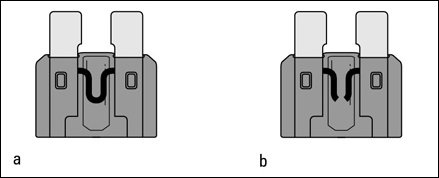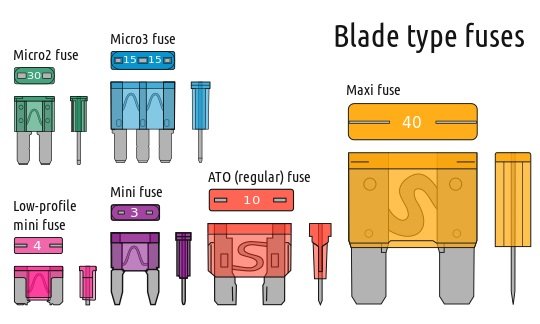Know More About Your Car Fuses
Basics: A fuse is nothing more than a short length of wire designed to melt and separate in the event of excessive current ( i.e wire short, overload, faulty component & etc ) so to protect the wiring and electrical equipments from more damage and fire. When a fuse blows, it opens a gap large enough so that an arc (which burns at a very high temperature) can't form between the terminals inside the fuse. A low voltage fuse like an AGU fuse may not be able to open a large enough gap to quench the arc. That would allow current to continue flowing (current would jump the gap in the fusible element in the form of an arc). This could result in an electrical fire.
Example:

A good blade-type fuse (a) and a blown one (b).
There are two important specifications for fuses. The first is simply the current rating. Fuses are rated for a given number of amps (amperes). Fuses are not rated in watts. If a fuse has 30 printed on it, it's a 30 amp fuse, not a 30 watt fuse. In automobiles, fuse rating is printed on top and they use a common coloring scheme for identification of fuse ratings (amps) as well. The second specification is the voltage. This isn't really important if you're simply replacing a fuse that has blown with the same type, especially in automobiles.

Fuses typically used in automobiles are generally rated no higher then 24 volts direct current. Automobile fuses are called as Blade fuses, Spade fuses or Plug-in fuses which is made of plastic body and two prongs that fit into sockets. There are six different physical sizes. ie micro2, micro3, low-profile mini, mini, regular, and maxi.


More info about car fuse, please visit following links:
http://en.wikipedia.org/wiki/Fuse_(automotive)
Changing a Fuse - Vehicle Maintenance - How To Guides at DMV.org: The DMV Made Simple
FUSES
How to Change a Vehicle's Fuses - For Dummies
@bhaveshce
Now back to your query. Like its said above, you don't have to worry about fuse voltages nor a car fuse has voltage rating printed. You just have to know the amps, fuse size and built quality of fuse. I have seen some fuses in local market that have poor built quality and I doubt there rated amps is correct. i.e a 10 amps fuse can pass more then 10A current instead of blowing or a 10 amps fuse cannot withstand rated amperes, instead blows when more then 5A but less then 10A current is passed. As of fuse size, most of cars use
mini type. Also you don't need plenty of fuses to keep incase of emergency. Just 2 to 3 fuses of each amperes is fine.
A fuse won't blow by itself but something wrong has occurred to the wires or the component so you shouldn't not replace the blown fuse to a new one because, in most cases it blows again so first you should check what caused that fuse to blow, resolve the cause and when everything looks fine, you can put a new fuse of a correct rating/color.
Hope I have fulfilled your query but feel free to ask more. It looks like Dr. is busy now-a-days so I thought to write up some details about car fuses with the help of info found online. May be its not complete but I hope it helps little.
Thanks...
Best Regards![Big Smile [:D] [:D]](https://www.theautomotiveindia.com/forums/images/smilies/Big%20Smile.gif)
![Thumbs Up [thumbsup] [thumbsup]](https://www.theautomotiveindia.com/forums/images/smilies/Thumbs%20Up.png) It is really good information which everybody should be aware of.
It is really good information which everybody should be aware of. ![Smile [:)] [:)]](https://www.theautomotiveindia.com/forums/images/smilies/Smile.gif)
![Wink [;)] [;)]](https://www.theautomotiveindia.com/forums/images/smilies/Wink.gif)
![Smile [:)] [:)]](https://www.theautomotiveindia.com/forums/images/smilies/Smile.gif)
![Smile [:)] [:)]](https://www.theautomotiveindia.com/forums/images/smilies/Smile.gif) )
)![Cheers [cheers] [cheers]](https://www.theautomotiveindia.com/forums/images/smilies/Cheers.gif)
![Roll Eyes [roll] [roll]](https://www.theautomotiveindia.com/forums/images/smilies/Roll.gif)

